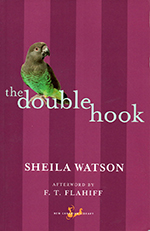 When planning this year’s reading project I put out a call for book recommendations; I received several, but the most common one was The Double Hook, by Sheila Watson. It didn’t make the cut for a number of reasons—mostly because my list was already pretty heavy on pre-CanCon material—but I added it as a “just in case” book, because I was having trouble locating copies of some of the other books. But December has rolled around, I’ve finished all twelve of my posts, and it turns out that I have time to do one more: my bonus book, The Double Hook.
When planning this year’s reading project I put out a call for book recommendations; I received several, but the most common one was The Double Hook, by Sheila Watson. It didn’t make the cut for a number of reasons—mostly because my list was already pretty heavy on pre-CanCon material—but I added it as a “just in case” book, because I was having trouble locating copies of some of the other books. But December has rolled around, I’ve finished all twelve of my posts, and it turns out that I have time to do one more: my bonus book, The Double Hook.
Sheila Watson’s prose was absolutely glorious. In a great many ways it reminded me of the best of Southern US writing; the same deceptively simple diction, the same idiosyncratic syntax, the same presentation of the mundane as the mythic. The Double Hook was gorgeous from beginning to end, but it wasn’t particularly lucid. I had tremendous difficulty telling one character from another,[ref]Seriously, who the fuck is “the boy”? Kip?[/ref] the relationships between the characters were not even remotely clear, and even who was present in a given scene was often an open question.
I’ve read that The Double Hook is considered by some to be Canada’s first Modernist novel, but it would depend on how you define Modernism. I’ve always preferred the definition that treats Modernism as a conscious attempt to re-write order into the world after the destructive chaos of the First World War. All the Modernist writers had a different idea of what that “order” should look like, and developed different literary structures to deal with the loss of stability and what they saw as the end of cultural continuity caused by the Great War. Canadian writers took different approaches to the same problem—but I don’t believe they ignored it until the 1950s. Some early Canadian Modernist writers created new structures; Martha Ostenso’s Wild Geese rebuilds the Canadian West as a Nordic saga. Others, like Gabrielle Roy and Sinclair Ross, tore down old structures in order to make room change. Watson goes further than those other writers, but I see what she’s doing in The Double Hook as different in degree rather than kind.
The new year will see me make one more post as part of this project; a final reflection on the project as a whole.